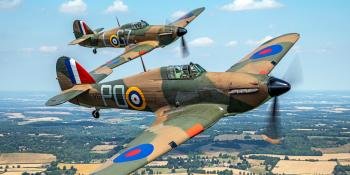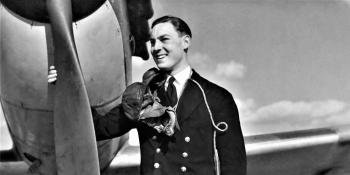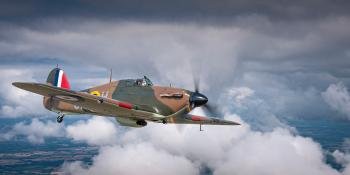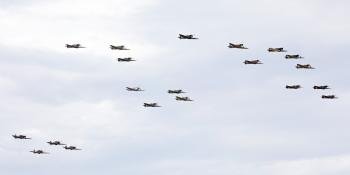Battle of Britain
In the summer and autumn of 1940, during the infamous Battle of Britain, both the Royal Air Force and Fleet Air Arm defended the nation from large-scale attacks by the Luftwaffe. Fought over the skies of southern England, Germany’s primary objective was to overwhelm and eradicate the RAF’s Fighter Command before launching an invasion. Considered to be one of the first campaigns fought entirely by aircraft, the brutal, unforgiving battle continued for more than three months. Germany, however, had underestimated the strength of Fighter Command, and were eventually forced to abandon their plans. While Britain’s success had been achieved at a heavy cost, with civilian casualties from July to December totaling more than 55,000, it proved to be a considerable morale boost for the country and demonstrated that the Luftwaffe was not invincible.
Battle of Britain Articles, Videos, quizzes and more...
Battle of Britain Quick History
Luftwaffe Background
With its fleet of 2,700 aircraft, the German Air Force (Luftwaffe) was one of the largest and most formidable forces in Europe prior to the campaign, severely outnumbering the Royal Air Force and Fleet Air Arm. Despite suffering heavy losses in the Battle of France, its squadrons had been returned to full operating capability by the start of June, including Luftflotten 2, 3 and 5, which were tasked with attacking targets from across the English Channel and the North Sea.
Despite its strength, the Luftwaffe was severely disadvantaged by its lack of strategy and frequent tactical errors. The force had been designed to provide close support for ground troops, and this was evidenced by its lack of heavy bombers which made it difficult to inflict strategic damage on targets. The Luftwaffe’s fighter force also had no effective method of plotting the positions of enemy aircraft and lacked any form of ground-to-air coordination.
Germany also suffered from logistical supply burdens and a lack of aircraft reserves, mainly because of underachievement in aircraft production. Their advance through Western Europe in spring 1940 had forced them to establish a network of poorly built bases across occupied Europe without adequate maintenance facilities, meaning that damaged aircraft had to be sent back to Germany for repair.
Timeline of Events
In July 1940, following the evacuation of British Expeditionary Forces at Dunkirk, Nazi Germany issued plans to invade Great Britain under Operation Sealion. With Britain retaining naval superiority, Germany’s High Command wanted to establish control of the skies above southern England, to enable the successful launch of an amphibious and airborne assault. These ambitious directives for aerial supremacy over the Royal Air Force and Fleet Air Arm would require the complete incapacitation of Fighter Command.
Believing the Royal Air Force was almost defeated by that stage, Reichsmarschall Hermann Göring was confident the offensive would take just 28 days to accomplish, subsequently allowing his bombers to perform raids beyond London without the need for fighter escort. While Germany’s initial Kanalkampf (channel fight) operations had focused primarily on harassing shipping convoys to lure Fighter Command into mass combat, Adolf Hitler soon ordered attacks on British military and economic targets.
On August 13, the Luftwaffe launched more than 1,500 aircraft as part of Adlertag (“Eagle Day”) - the commencing phase of Unternehmen Adlerangriff (Operation Eagle Attack). During the early hours of that morning, Dornier Do 17s from Kampfgeschwader 2 (KG2) bomber unit delivered the Luftwaffe’s first attacks, striking Coastal Command’s RAF Eastchurch after ill-served German intelligence had incorrectly identified the target as a fighter base. Despite continued attacks on coastal airfields and radar stations throughout the day and into the night, Adlertag proved to be relatively ineffective, with many bombers being forced back by poor weather, and lengthy breaks in between raids allowing stations to recover.
During August 15 - dubbed “the greatest day” by Nazi Germany - the Luftwaffe mounted its largest number of sorties during the campaign. Just three days later, however, its fleet of Junker Ju 87 Stukas endured significant losses during flights over the Isle of Wight and Kent. In a subsequent attempt to preserve aircraft numbers, Göring reluctantly withdrew the type from the Battle of Britain - ultimately sounding the end of the dive bomber’s involvement in the campaign. By the end of that month, the intensity of combat had increased dramatically, stretching an already depleted and exhausted Luftwaffe that had lost more than 600 aircraft.
During early September, in retaliation to the Bomber Command’s devastating raids over Berlin, the Luftwaffe shifted its focus towards attacking London for the first time, inflicting severe damage on its docks, gasworks, power stations, and oil storage tanks at Thameshaven. These raids would continue throughout the following nine months, in what became known as the infamous Blitz. Whilst London and other industrial cities suffered dearly, this change of tactics relieved some of the pressure that had been exerted on Britain’s defences, enabling the RAF to replenish and re-strengthen its bruised Fighter Command with new aircraft and pilots.
With Hitter becoming skeptical of the Luftwaffe’s ability to consume the Royal Air Force for aerial ascendency, and increasingly irritated by Sealion’s lack of progress, Germany launched two final waves of attack on September 15. The RAF were well prepared, nonetheless, with 17 squadrons deployed to meet the threat. The interval between each wave also allowed Spitfires and Hurricanes to return to base for refuelling and rearmament, thus presenting Britain with a further advantage. While dogfighting continued for another month, this date in 1940 - commemorated as “Battle of Britain Day” - is often regarded as the climax of the campaign. Just two days later, Hitler postponed his operation to invade Britain indefinitely.
The Dowding System
Although Göring’s tenacity and confidence may have driven the significant expansion of the Luftwaffe prior to the Battle of Britain, the Commander-in-Chief had failed to comprehend the effectiveness of the Royal Air Force’s advanced ground-controlled interception network. Affectionately nicknamed the "Dowding system", it comprised a set of Chain Home radar stations along the south and east coasts of England, using Radio Direction Finding (RDF) and observation to detect approaching enemy aircraft.
Through telephone communication, rapidly collected information would then be fed to a filter room in Fighter Command’s Headquarters at Bentley Priory, and subsequently forwarded onto the various Sector Stations around the country. This vital asset dramatically improved the speed and accuracy of transmissions, presenting Britain’s fighter groups with an advanced interception warning, and enabling squadrons to maximise their valuable and limited resources. Its impact was further augmented by German intelligence’s failure to recognise the importance of the radar towers, and rarely instructing attacks on them.
Pilots
Many pilots received tremendous accolade for their bravery in the Battle of Britain, including one notable individual: Douglas Bader. Having lost both of his legs in an accident while performing aerobatics in December 1931, Bader re-joined the Air Force eight years later before taking command of No. 242 Squadron at RAF Coltishall. His squadron went on to achieve great success against the Luftwaffe, shooting down ten enemy aircraft on just one day alone. In recognition of his combat leadership, he was awarded the Distinguished Service Order.
Fighter Command was also very much an international force, with almost a fifth of pilots coming from Commonwealth nations or occupied Europe. The Royal Air Force’s Battle of Britain roll of honour recognises 595 non-British pilots as flying at least one operational sortie with the RAF or Fleet Air Arm, including men from New Zealand, Australia, Canada, South Africa, Belgium, France, Poland, Czechoslovakia, and Barbados.
The willingness to help defend Britain against Nazi Germany was so significant that the War Cabinet created two Polish fighter squadrons, Nos. 302 and 303, in the summer of 1940, followed by further national units. No.303 entered the campaign on August 31 at the height of conflict, but quickly became Fighter Command’s highest claiming squadron with more than 120 kills. One of the highest scoring allied pilots during the battle, Sgt Josef Frantisek, was a Czech serviceman flying Hurricanes with the Polish Fighter Squadron from RAF Northolt.
Aircraft
Originally conceived as an interceptor, the Messerschmitt Bf 109E predominantly served as a fighter escort throughout the Battle of Britain, providing close air support for the cumbersome, slow-moving Heinkel He111s and Bf 111s bombers. Although the aircraft was often faster at high altitude and could dive more rapidly in comparison to its Spitfire counterpart, the Bf 109 was plagued by an inability to fly beyond London as a result of its limited range. Its operational effectiveness was also hampered by the fact it could not carry more than seven seconds worth of cannon ammunition.
The twin-engined Messerschmitt Bf 110C was designed as a long-range heavy escort fighter or Zerstörer (destroyer), but would often engage in air-to-air combat while escorting the Luftwaffe bomber fleet. Despite being well-armed, its lack of maneuverability and acceleration made it vulnerable and markedly inferior to the RAF’s fighters. The aircraft proved to be more effective when used for low-level attacks against factories and airfields, but the Luftwaffe failed to notice the type’s potency in this fighter-bomber role with just one unit ever being tasked for such work.
The formidable Supermarine Spitfire rose to prominence over the course of the campaign, becoming a legendary icon for Britain. Armed with either .303in Browning machine guns or 20mm cannons, it was the only fighter capable of competing with the Bf 109E. By July 1940, nineteen of Fighter Command’s squadrons were equipped with the Spitfire Mk I, which soon gave way to the more advanced and powerful Mk II variant.
Manufactured from a combination of both wood, metal and fabric, the Hurricane was a rather stable and rugged aircraft that could be maintained and repaired more easily than the Spitfire. Hurricane squadrons were often directed against enemy bombers while the superior Spitfires dealt with the fighter escorts. Although its thicker wing profiles compromised acceleration, and its fabric material often allowed fire to spread through the fuselage more easily, the fighter still managed to down more than 650 German aircraft by the end of the campaign.









